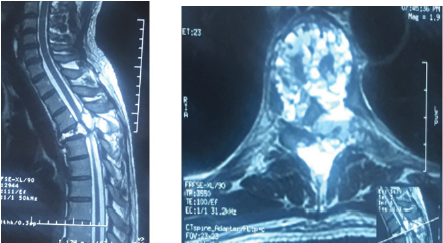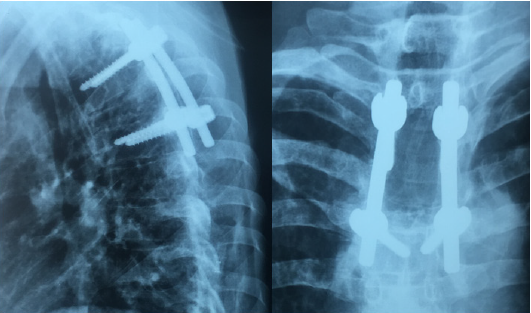
Lupine Publishers Group
Lupine Publishers
Menu
ISSN: 2637-6628
Case Report(ISSN: 2637-6628) 
Paraparesis caused by Aneurysmal Bone cyst (ABC) Volume 3 - Issue 1
Y Joulali1*, F Lakhdar1, M Benzagmout1, K Chakour1 and MF Chaoui1
- 1Department of Neurosurgery, Hassan II University Hospital, Morocco
Received:August 13, 2019; Published: August 19, 2019
Corresponding author: Y Joulali, Department of Neurosurgery, Hassan II University Hospital, Morocco
DOI: 10.32474/OJNBD.2019.03.000155
Abstract
Through the study of a case of spinal aneurysmal bone cyst managed in the Department of Neurosurgery at Hassan II University Hospital of Fez we focus our discussion of various aspects of this rare disease.
Our study concerns a male patient admitted to the emergency department for spinal cord compression that necessitated a spinal MRI. It showed T4 vertebral compression, hypointense T1, hyperintense T2 with hematic fluid levels causing spinal cord compression. The patient underwent surgical treatment with good clinical outcome. Histological study revealed a spinal aneurysmal bone cyst.
Keywords: Aneurysmal cyst; MRI-surgery; Embolization
Introduction
The aneurysmal bone cyst is a benign lesion with an aggressive character. It represents 1.4% of primary bone tumors, its spinal localization remains uncommon (3-30%) and spinal syndrome is the most frequent reason for consultation [1]. Plain radiography and CT have a significant role in its diagnosis, but MRI remains the investigation of choice. The management of spinal aneurysmal bone cyst remains controversial.
Case
A 40 years old man, chronic smoker (a packet/day) was admitted to the emergency for a spinal syndrome for 2 years that was complicated 2 months before admission by the appearance of a grade D paraparesis, hypoesthesia with a sensory level at xiphoid process and urinary incontinence. The spinal MRI showed compaction of T4 vertebra with a heterogenous hyperintensity on T2 and STIR, a hyperintensity on T1 with heterogeneous enhancement of hematic fluid levels causing spinal cord compression at same level (Figure 1). The management consisted of performing a laminectomy of T3-T4 with pedicle screw and rod fixation of T3 and T5 vertebra (Figure 2). The postoperative course was marked by improved clinical signs. The Histopathology report came back in favor of aneurysmal bone cyst.
Figure 1: Spinal T2 weighted MRI showing (a) sagittal view with T4 compression and (b) Axial view with fluid level spaces.

Figure 2: Spinal X-ray Lateral and anteroposterior showing post-operative pedicle screw and rod system.

Discussion
Aneurysmal Bone Cyst (ABC) is a benign cystic lesion composed of blood-filled spaces, devoid of coating endothelial, muscle or elastic, surrounded by fibroblasts, described for the first time by Jaffe and Lichtenstein in 1942 [2]. Its incidence is 0.14 per 100,000 individuals with a female predominance (ratio 1.16) [3]. For Lichtenstein [4], the ABC is a secondary bone lesion due to hemodynamic imbalance resulting in a significant capillary dilatation, resulting from an increase in venous pressure. This increase in venous pressure might be due to venous thrombosis or abnormal arteriovenous communication. Biesecker et al [5] measured the intracystic pressure which was identical to that of arterioles and concluded that this hypertension is due to an arteriovenous fistula following a secondary lesion. Some authors [6-8] think that the appearance of an aneurysmal bone cyst would be secondary to impaired intraosseous vascular flow in the phase of consolidation following trauma. However, several cases of familial aneurysmal bone cysts [9,10] have been reported, hence orienting towards a genetic origin and indeed the genetic and immunohistochemical studies [11] have demonstrated a translocation on chromosome [7].
Aneurysmal bone cyst is most frequently found in the long bones especially the metaphyseal region [12,13], while the spinal location remains rare and affects the cervical, thoracic, lumbar and sacrum, with no case of coccygeal bone ABC reported [14]. Clinically, spinal ABC may be asymptomatic [1], but usually it manifests itself as a spinal disorder, with or without spinal cord compression signs. MRI remains the examination of choice which shows a welldemarcated bone lesion, hypointense on T1, hyperintense on T2 with a peripheral border taking contrast, defining spaces with fluid level [4]. Surgery that involves wide excision represents the preferred treatment of choice for ABC with a recurrence rate of 25% and multiple complications such as deformation and growth disorders [15]; For these reasons, selective arterial embolization was introduced into the management of this entity that proves similarly effective and with fewer complications, representing the treatment of choice in cases where the patient shows no deficit or unstable associated fractures [16]. Radiation therapy, which was an important pillar in the therapeutic arsenal, was gradually abandoned because of the risk of exposure and development of radiation-induced sarcomas [17]. Other therapeutic protocols have been proposed: the intralesional injection of calcitonin, and doxycycline Ethibloc [17-20], however they have not proven effective as with other therapeutic methods. Currently, research [21-23] has focused on the interest of Denosumab, a monoclonal antibody used in the treatment of giant cell tumors, and the intrinsic stimulation by the mesenchymal stem cells and have both shown promising results [24,25].
Conclusion
Aneurysmal bone cyst is a benign disease with unpredictable course, and thus what makes its treatment a challenge especially in locations where access is difficult. Surgery and embolization currently remain the treatment protocol of choice. Research on Mesenchymal stem cells and Denosumab have demonstrated promising results in the therapeutic management of ABC.
References
- Mehmet Zileli, Hasan Serdar Isik, Fatih Ersay Ogut, Merih IS, Sedat Cagli (2013) Aneurysmal bone cysts of the spine. Eur Spine J 22(3): 593-601.
- Jaffe H, Lichtenstein L (1942) Solitary unicameral bone cyst: With emphasis on the roentgen picture, the pathologic appearance and the pathogenesis. Arch Surg 44: 1004-1025.
- Leithner A, Windhager R, Lang S, Haas OA, Kainberger F, et al. (1999) Aneurysmal bone cyst. A population based epidemiologic study and literature review. Clin Orthop Relat Res 363: 176-179.
- J Cottalorda S (2007) Bourelle The original aneurysmal bone cyst: what's new in 2006?: Aneurysmal bone cyst in 2006. Review of Orthopedic Surgery and Repair of the Motor Device 93(1): 5-16.
- Bieseckerjl, Marcoverc, Huvosag, Mike V (1970) Aneurysmal bone cysts: A clinicopathologic study of 66 cases. Cancer 26(3): 615-625.
- Dabezies Ej, Dambrosia Rd, Chuinard Rg, Ferguson (1982) Ab Aneurysmal bone cysts after fracture; report of three cases. J Bone Joint Surg (Am) 64(4): 617-621.
- Ginsburg Ld (1974) Congenital aneurysmal bone cyst. Case report with comments on the role of trauma in the pathogenesis. Pediatr Radiol 110(1): 175-176.
- Ratcliffe PJ, Grimer J (1993) Aneurysmal bone cyst arising after tibial fracture. J Bone Joint Surg (Am), 75(8): 1225-1227.
- Power Ra, Robbins Pd, Wood DJ (1996) Aneurysmal bonecyst in monozygotic twins: A case report. J Bone Joint Surg (Br) 78(2): 323-324.
- Leithner A, Windhager R, Kainberger F, Lang S (1998) A case of aneurysmal bone cyst in father and son. Eur J Radiol 29(1): 28-30.
- Althof PA, Ohmori K, Zhou M, Bailey JM, Bridge RS, et al. (2004) Cytogenetic and molecular cytogenetic findings in 43 aneurysmal bone cysts: aberrations of 17p mapped to 17p13.2 by fluorescence in situ hybridization. Mod Pathol 17(5): 518-525.
- Sullivanr J, Meyer JS, Dormans JP, Davidson RS (1999) Diagnosing aneurysmal and unicameral bone cysts with magnetic resonance imaging. Clin Orthop 366: 186-190.
- Campanacci M, Capanna R, Picci P (1986) Unicameral and aneurysmal bone cysts. Clin Orthop 204: 25-36.
- Cottalorda J, Gouin F (2005) Aneurysmal bone cyst. In: Chotel F, Gouin F. Benign Bone Tumors (Benign `osseous tumors). Elsevier, pp. 188-200.
- Tillman BP, Dahlin DC, Lipscomb PR, Stewart JR (1968) Aneurysmal bone cyst: An analysis of ninety-five cases. Mayo Clin Proc 43(7): 478-495.
- Amendola L, Simonetti L, Simoes CE, Bandiera S, De Iure F, et al. (2013) Aneurysmal bone cyst of the mobile spine: The therapeutic role of embolization. Eur Spine J 22(3): 533-541.
- Szendroi M, Antal I, Liszka G, Konya A (1992) Calcitonin therapy of aneurysmal bone cysts. J Cancer Res Clin Oncol 119(1): 61-65.
- Scaglietti O, Marchetti PG, Bartolozzi P (1982) Final results obtained in the treatment of bone cysts with methylprednisolone acetate (depo-medrol) and a discussion of results achieved in other bone lesions. Clin Orthop Relat Res 165: 33-42.
- Funayama T, Gasbarrini A, Ghermandi R, Girolami M, Boriani S (2016) Solitary bone cyst of a lumbar vertebra treated with percutaneous steroid injection: a case report and review of literature. Eur Spine J 26(Suppl 1): 58-62.
- Shiels WE 2nd, Mayerson JL (2013) Percutaneous doxycycline treatment of aneurysmal bone cysts with low recurrence rate: a preliminary report. Clin Orthop Relat Res 471(8): 2675-2683.
- Pauli C, Fuchs B, Pfirrmann C (2014) Response of an aggressive periosteal aneurysmal bone cyst (ABC) of the radius to denosumab therapy. World J Surg Oncol 12: 1-17.
- Dubory A, Missenard G, Domont J, Court C (2016) Interest of Denosumab for the treatment of giant-cells tumors and aneurysmal bone cysts of the spine. About nine cases. Spine (Phila Pa 1976) 41(11): 654-660.
- Barbanti Brodano G, Terzi S, Trombi L, Griffoni C, Valtieri M, Boriani S, Magli MC (2013) Mesenchymal stem cells derived from vertebrae (vMSCs) show best biological properties. Eur Spine J 22(Suppl 6): 979-984.
- Giovanni Barbanti-Brodano, Marco Girolami, Riccardo Ghermandi, Silvia Terzi, Alessandro Gasbarrini (2017) Aneurysmal bone cyst of the spine treated by concentrated bone marrow: Clinical cases and review of the literature. Eur Spine J 26(Suppl 1): 158-166.
- Bipin Chaurasia (2018) Aneurysmal Bone Cyst of the Occipital Bone. EC Neurology 10(12): 1047-1051.

Top Editors
-

Mark E Smith
Bio chemistry
University of Texas Medical Branch, USA -

Lawrence A Presley
Department of Criminal Justice
Liberty University, USA -

Thomas W Miller
Department of Psychiatry
University of Kentucky, USA -

Gjumrakch Aliev
Department of Medicine
Gally International Biomedical Research & Consulting LLC, USA -

Christopher Bryant
Department of Urbanisation and Agricultural
Montreal university, USA -

Robert William Frare
Oral & Maxillofacial Pathology
New York University, USA -

Rudolph Modesto Navari
Gastroenterology and Hepatology
University of Alabama, UK -

Andrew Hague
Department of Medicine
Universities of Bradford, UK -

George Gregory Buttigieg
Maltese College of Obstetrics and Gynaecology, Europe -

Chen-Hsiung Yeh
Oncology
Circulogene Theranostics, England -
.png)
Emilio Bucio-Carrillo
Radiation Chemistry
National University of Mexico, USA -
.jpg)
Casey J Grenier
Analytical Chemistry
Wentworth Institute of Technology, USA -
Hany Atalah
Minimally Invasive Surgery
Mercer University school of Medicine, USA -

Abu-Hussein Muhamad
Pediatric Dentistry
University of Athens , Greece

The annual scholar awards from Lupine Publishers honor a selected number Read More...




